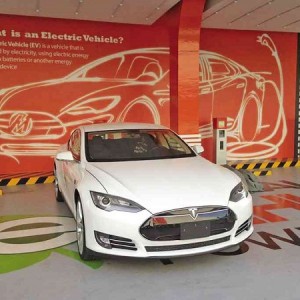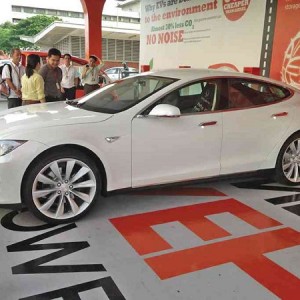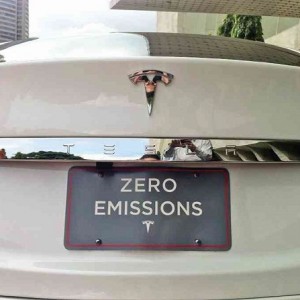Beyond the plug

THE FUTURE of motoring is electric as Meralco inaugurates the first electric-vehicle charging station. Photo from facebook.com
Manila Electric Co. (Meralco), the country’s biggest electric power distributor, made Philippine automotive history on Tuesday (July 30) when it inaugurated the first electric vehicle (EV) charging station within its own compound in Pasig City. The very first customer to plug in is Meralco chair Manuel V. Pangilinan, as he started using the station to charge his personal Tesla S sedan. The white four-door, recently imported into the country, proudly bears a rear plate stating “Zero Emissions.”
Likewise, Meralco will use the electric charging station in cooperation with Mitsubishi Motors. Mitsubishi will make available several units of its iMIEV electric car to the power utility. Meralco aims to “highlight the future of land transportation using green fuel,” and encourage use of electricity for commercial use in cars.
Is electricity really a green “fuel”? Of course, pure electric cars are classified as zero emissions, but in reality they are remote-emissions vehicles, their energy having been generated elsewhere and simply transmitted to the EV charging station and to the car’s batteries.
How clean electricity is as a vehicle power source depends on how that power has been generated. If the power plant is using coal, then it may be considered one of the dirtiest sources of electrical energy.
Coal has been cited by scientists, doctors, and environmentalists as a pollutant at all stages of its conversion to energy: when it is mined, transported, stored, and particularly when it is burned. Coal-fired power plants have been shown to cause soot, smog, acid rain; its high level of carbon emissions contribute to global warming. Coal is estimated to be only 33 percent efficient at converting fuel to energy, not much better than an efficient internal-combustion engine.
Article continues after this advertisementArticle continues after this advertisement
Positive for renewables
The Philippines is currently using mostly coal to generate its power. Nearly 39 percent of our electrical energy comes from coal-fired power plants. Natural gas is second at about 27 percent. What is positive is that hydroelectric and geothermal at 14 percent each, with other renewables at less than one percent. That adds up to 29 percent, which combines favorably with Germany’s 25 percent. (If we look at Luzon, where the charging stations will presumably be first stationed, the total for renewables is 17 percent.)

WITH the use of renewable energy sources, electric cars can be the cleanest forms of motorized transport.
We must note, however, that our hydro and geothermal accounted for 55 percent in 1991, with coal at below 10 percent in that year. So most of the installed capacity since then has been in coal-fired power plants.
In favor of electric vehicles is the high efficiency of electric motors, approaching 90 percent. So at the point of the motor vehicle itself, the car makes the most efficient use of its power source.
Another concern with electrics and hybrids is what happens to the battery at the end of its life. Toyota has previously revealed to Inquirer Motoring that it can recycle and reuse the nickel metal hydride batteries in its Prius hybrids. The company has achieved full recycling of all batteries within Japan. Tesla reports that it can recycle 60 percent of its battery packs, and reuse another 10 percent.
Meralco is certainly taking an important first step in introducing electric technology to Metro Manila. If it will dot the city with several charging stations in convenient and accessible locations, it will remove the biggest obstacle to electric-car adoption. That would be range anxiety, or the worry that one will run out of charge before getting to his destination.
The next step for Meralco, which it is uniquely positioned to, is to look at its sources of electrical energy and to balance the cost and availability of the various sources with their environmental impact. Only then would electric motoring truly be the cleanest, most earth-friendly means of motorized transportation.
